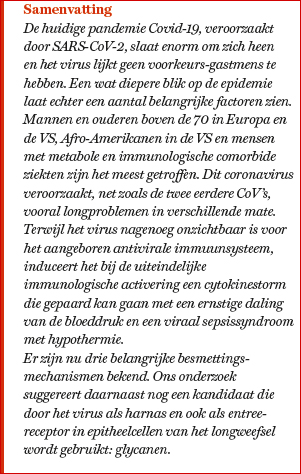SARS-CoV-2 en de rol van glycanen
05 May, 2020
Door: Leo Pruimboom
 Er bestaan tot nu toe nog geen goede verklaringen voor de verschillen in besmettingsgevoeligheid en mortaliteit, al laat de epidemiologie toe om in ieder geval een aantal hypotheses te ontwikkelen, die kunnen helpen met het in kaart brengen van mogelijke primaire en secundaire preventieve interventies. De rol van glycanen in het mondbioom zou wel eens zó cruciaal kunnen zijn dat een vaccin versneld dichterbij kan komen.
Er bestaan tot nu toe nog geen goede verklaringen voor de verschillen in besmettingsgevoeligheid en mortaliteit, al laat de epidemiologie toe om in ieder geval een aantal hypotheses te ontwikkelen, die kunnen helpen met het in kaart brengen van mogelijke primaire en secundaire preventieve interventies. De rol van glycanen in het mondbioom zou wel eens zó cruciaal kunnen zijn dat een vaccin versneld dichterbij kan komen.
Op het moment van schrijven heeft het SARS-CoV-2 meer dan 2 miljoen mensen besmet en meer dan 130.000 mensen zijn aan de gevolgen van het infect gestorven. Verdere epidemiologische data tonen dat vooral mensen boven de 65 jaar, mannen en mensen die lijden aan comorbide ziektebeelden het meest kwetsbaar zijn en ernstige symptomatiek ontwikkelen. De geo-epidemiologie laat zien, dat vooral sterk geïndustrialiseerde landen of delen ervan het hoogste besmettingsgevaar en sterfte vertonen.
De meest opvallende epidemiologische kenmerken met betrekking tot SARS-CoV-2-besmetting en mortaliteit zijn deze:
- Meer mannen dan vrouwen sterven aan SARS-CoV-21
- Ouderen zijn gevoeliger voor besmetting en sterfte2
- Kinderen zijn min of meer immuun voor symptomatische SARS-CoV-23
- SARS-CoV-2 heeft 10 à 20 keer meer aanhechtingscapaciteit aan hACE 2 dan SARS-CoV-1 en repliceert daarom versneld in de orale ruimte en besmet mensen4
- De meeste besmettingen worden waargenomen in grote steden5
Wat zijn de mogelijke mechanismen van besmetting? Ten eerste blijkt dat het longweefsel van oudere mensen een hogere expressie vertoont van het gen voor de productie van ACE 2 via hypomethylatie van dat gen.6 Genexpressie, en daarmee de productie van het overeenkomstige eiwit, wordt bepaald door de mate van methylatie van de promotorcode (een zogenaamd CpG eiland). De ACE 2-receptor en furine worden samen beschouwd als de twee belangrijkste virusreceptoren voor SARS-CoV-2 in de humane gastheer.7,8 Een virusreceptor wordt door een virus gebruikt om zichzelf te laten endocyteren (op te nemen in de cel) en daarna haar virusmembraan te laten versmelten met de celmembraan; de fusie tussen de virusmembraan en de celmembraan en/of de fusie tussen twee cellen wordt een syncytium genoemd. Het zogenaamde spike-glycoproteïne S (de kroonvormende glycoproteïnenuitsteeksels van het virus) bestaat uit twee subunits: S1 en S2. S1 is nodig voor het aanhechten aan een of ander celmembraanmolecuul, terwijl S2 verantwoordelijk is voor het samensmelten, c.q. fuseren van het virus met de geïnfiltreerde celmembraan.
www.cpnieurope.nl Lees het gehele artikel vanaf pagina 18 in OrthoFyto 3/20. Wilt u het gehele artikel als PDF bestand ontvangen? Bestel het dan hier voor € 3,50. Bronvermelding:- Jin, J.-M., Bai, P., He, W., Wu, F., Liu, X.-F., Han, D.-M., Liu, S., & Yang, J.-K. (2020). Gender differences in patients with COVID-19: Focus on severity and mortality. MedRxiv, 2020.02.23.20026864.
- Pinto, B. G., Oliveira, A. E., Singh, Y., Jimenez, L., Goncalves, A. N., Ogava, R. L., Creighton, R., Peron, J. P., & Nakaya, H. I. (2020). ACE2 Expression is Increased in the Lungs of Patients with Comorbidities Associated with Severe COVID-19. MedRxiv, 2020.03.21.20040261.
- Lu X et al. Chinese Pediatric Novel Coronavirus Study Team. SARS-CoV-2 Infection in Children. N Engl J Med. 2020 Mar 18. doi: 10.1056/NEJMc2005073.
- Li G, He X, Zhang L, Ran Q, Wang J, Xiong A, Wu D, Chen F, Sun J, Chang C. Assessing ACE2 expression patterns in lung tissues in the pathogenesis of COVID-19. J Autoimmun. 2020 Apr 13:102463
- Sun, Z., Thilakavathy, K., Kumar, S. S., He, G., & Liu, S. V. (2020). Potential factors influencing repeated SARS outbreaks in China. International Journal of Environmental Research and Public Health, 17(5), 1–11.
- Corley, M.,et al. DNA Methylation Analysis of the COVID-19 host cell receptor, Angiotensin I Converting Enzyme 2 gene (ACE2) in the Respiratory System Reveal Age and Gender Differences. Preprints 19 maart 2020.
- Andersen, K. G., Rambaut, A., Lipkin, W. I., Holmes, E. C., & Garry, R. F. (2020). The proximal origin of SARS-CoV-2. Nature Medicine, 2–4.
- Abassi ZA, et al. Covid-19 infection and mortality - A physiologist's perspective enlightening clinical features and plausible interventional strategies. Am J Physiol Lung Cell Mol Physiol. 2020 Mar 24.
- Braun, E., & Sauter, D. (2019). Furin-mediated protein processing in infectious diseases and cancer. Clinical and Translational Immunology, 8(8), 1–19.
- Matsuyama S, et al. Enhanced isolation of SARS-CoV-2 by TMPRSS2-expressing cells. Proc Natl Acad Sci U S A. 2020 Mar 31;117(13):7001-7003. doi: 10.1073/pnas.2002589117. Epub 2020 Mar 12.
- Wrapp, D.et al. (2020). Cryo-EM structure of the 2019-nCoV spike in the prefusion conformation. Science, 367(6483), 1260–1263.
- Xia, S., Liu, M., Wang, C., Xu, W., Lan, Q., Feng, S., Qi, F., Bao, L., Du, L., Liu, S., Qin, C., Sun, F., Shi, Z., Zhu, Y., Jiang, S., & Lu, L. (2020). Inhibition of SARS-CoV-2 (previously 2019-nCoV) infection by a highly potent pan-coronavirus fusion inhibitor targeting its spike protein that harbors a high capacity to mediate membrane fusion. Cell Research, 2(February).
- Ou, X.et al. (2019). Characterization of spike glycoprotein of SARS-CoV-2 on virus entry and its immune cross-reactivity with SARS-CoV. Nature Communications, (2020).
- Jones, M. J., Goodman, S. J., & Kobor, M. S. (2015). DNA methylation and healthy human aging. Aging Cell, 14(6), 924–932.
- Holmes, L et al (2019). DNA methylation of candidate genes (ACE II, IFN-Γ, AGTR 1, CKG, ADD1, SCNN1B and TLR2) in essential hypertension: A systematic review and quantitative evidence synthesis. International Journal of Environmental Research and Public Health, 16(23).
- Sawalha, A. H.et al (2020). Epigenetic dysregulation of ACE2 and interferon-regulated genes might suggest increased COVID-19 susceptibility and severity in lupus patients. Clinical Immunology, 215, 108410.
- Mehta, P., McAuley, D. F., Brown, M., Sanchez, E., Tattersall, R. S., & Manson, J. J. (2020). COVID-19: consider cytokine storm syndromes and immunosuppression. The Lancet, 395(10229), 1033–1034.
- Li, H., Liu, L., Zhang, D., Xu, J., Dai, H., Tang, N., … Cao, B. (2020). SARS-CoV-2 and viral sepsis: observations and hypotheses. The Lancet, 0(0).
- El Zowalaty, M. et al (2020). From SARS to COVID-19: A previously unknown SARS- related coronavirus (SARS-CoV-2) of pandemic potential infecting humans – Call for a One Health approach. One Health, 9(February), 22–27.
- Walden, M. et al (2019). Metabolic control of BRISC–SHMT2 assembly regulates immune signalling. Nature, 570(7760), 194–199.
- Hoffmann, M. et al. (2020). SARS-CoV-2 Cell Entry Depends on ACE2 and TMPRSS2 and Is Blocked by a Clinically Proven Protease Inhibitor. Cell, 1–10.
- Guo, Y. R., Cao, Q. D., Hong, Z. S., Tan, Y. Y., Chen, S. D., Jin, H. J., Tan, K. Sen, Wang, D. Y., & Yan, Y. (2020). The origin, transmission and clinical therapies on coronavirus disease 2019 (COVID-19) outbreak - an update on the status. Military Medical Research, 7(1), 11.
- Dupressoir, A., Lavialle, C., & Heidmann, T. (2012). From ancestral infectious retroviruses to bona fide cellular genes: Role of the captured syncytins in placentation. Placenta, 33(9), 663–671.
- Chuong, E. B. (2018). The placenta goes viral: Retroviruses control gene expression in pregnancy. PLoS Biology, 16(10), 1–7.
- Matoušková, M., et al (2006). CpG methylation suppresses transcriptional activity of human syncytin-1 in non-placental tissues. Experimental Cell Research, 312(7), 1011–1020.
- Sfera, A., Fayard, L., Osorio, C., & Price, A. (2018). Epigenetic interventions for brain rejuvenation: Anchoring age-related transposons. Neural Regeneration Research, 13(4), 635–636.
- Sfera, A., Bullock, K., Price, A., Inderias, L., & Osorio, C. (2018). Ferrosenescence: The iron age of neurodegeneration? Mechanisms of Ageing and Development, 174, 63–75.
- Zhou, F et al (2020). Clinical course and risk factors for mortality of adult inpatients with COVID-19 in Wuhan, China: a retrospective cohort study. The Lancet, 395(10229), 1054–1062.
- Cross, B. W., & Ruhl, S. (2018). Glycan recognition at the saliva – oral microbiome interface. Cellular Immunology, 333(August)
- Koropatkin, N. M., Cameron, E. a, & Martens, E. C. (2014). How Glycans Shape. 10(5), 323–335.
- Blaser, M. J., & Falkow, S. (2009). What are the consequences of the disappearing human microbiota? Nature Reviews Microbiology, 7(12), 887–894.
- Chen C, Feng P, Slots J. Herpesvirus-bacteria synergistic interaction in periodontitis. Periodontol 2000. 2020 Feb;82(1):42-64.
- Watanabe Y, Bowden TA, Wilson IA, Crispin M. Exploitation of glycosylation in enveloped virus pathobiology. Biochim Biophys Acta Gen Subj. 2019 Oct;1863(10):1480-1497. Epub 2019 May 20.
